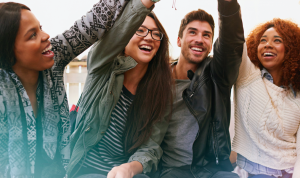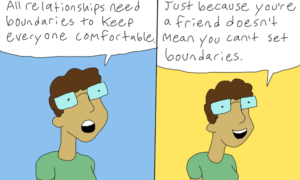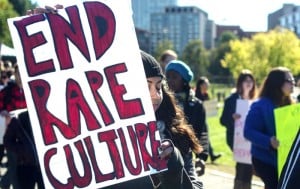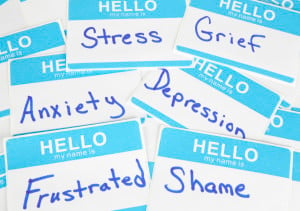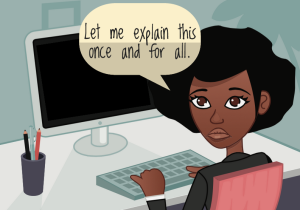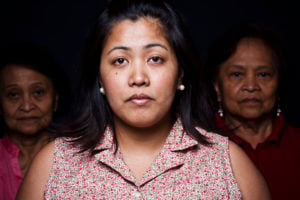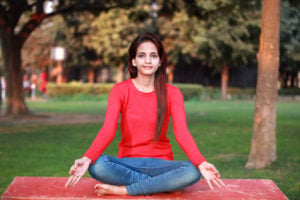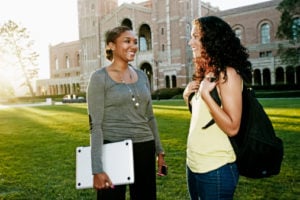I’ve always loved parties. Especially themed parties. Especially holiday parties.
There is an old home movie of me on Christmas when I’m two, sitting with my post-op little be-casted legs stretched out in front of me as I reach for all my relatives, who perhaps have presents, shouting joyously, “Open, open, open!”
My favorite holiday, other than all of them, or that magical combination of Halloween and Christmas Jack Skellington invented, is my birthday. I throw myself a party every year. This past year (December 13th!), the theme was a post-future dystopic/disability justice take on America’s Next Top Model called ANTM Cycle X: DysBeauty.
And one of the first parties that I ever threw in the Bay Area, where I live, was a combination of a fundraiser for Sins Invalid and a birthday party for my friends, in conjunction with Hella Gay. This was when Hella Gay was still being hosted at a wheelchair accessible venue, so I didn’t plan much around the location other than how and where the Bounce House was being dropped off.
Oh, the Bounce House wasn’t for me. I got it for all the leg jumpy enthusiasts. I wanted people to like my party!
For me, as a kid who grew up physically disabled around few other disabled people, I have been used to not prioritizing my own access, let alone prioritizing access of other disabled people. Whatever got me to the party, and didn’t make anyone question the validity of my body in the room or my ability to be fun, was what I was willing to do.
Since then, however, I’ve learned so much more about what accessibility can and should mean. I have been spending all this time werking for parties when the parties should be werking for me. And other others, too. What is marginally accessible at a party to me – as an extroverted, manual and power chair user – is not necessarily accessible to, say, a socially anxious person with multiple chemical sensitivities.
If someone wants to party, if someone wants to let loose and dance, if someone wants to throw down for a cause, if someone wants to celebrate with their community, then I want them to feel welcome in the space they desire to be in. I want them to feel like their body was considered. And, as intersectional feminists and social justice activists, you should want this, too.
If you are a non-disabled person, in order to start thinking more accessibly, you have to start thinking with your whole body.
You have to get aware of your privileges as a non-disabled person. You can start by attending a party you have a feeling you will feel comfortable at and noting what makes you feel comfortable.
But until then, the following questions are a little taste, a pre-gamer if you will, to get you ready for your next amazing, super fun, much more accessible party.
1. What Is Accessibility – And Why Does It Matter?
The path from inaccessible to accessible is not an A to B kind of thing. It’s not a direct shot. It’s as meandering and scenic as a long ramp to a tall house. And that ramp, that path, is worth it.
While the ADA is very helpful as a place to start, I choose not to rely solely on institutional models of accessibility or disability. And as a disability justice activist, I sit with others to define disability broadly, including people with mobility impairments (congenital, developing, or acquired), people of a sensory minority, people who are neurodivergent, people who experience psychic difference or mental illness, people with emotional disabilities, people with chronic illness, chronic fatigue, and/or chronic pain.
Something is accessible if multiple kinds of bodies outside of the normative standard of how a body should function can access a space comfortably, functionally, and happily.
It means we can move and breathe as we wish, appreciate art, company, amenities, and the overall experience.
Unfortunately, ableism still comes close to last, if not last, on the lists of isms to wipe from the club kid circuit. I still find myself writing on Facebook events and messaging people to ask for the access info of parties, performances, and community events to be listed.
If there are access needs that you have reason to believe your party will not be able to meet, be honest with yourself and your potential guests about this. But remember: People know themselves best. Never suggest that someone shouldn’t come because you don’t know if something will be accessible to them, but post and share as much information as possible about the relative accessibility of your party space.
The information that you do or do not share says a lot about who you believe is in your community. For instance, when a party chooses to center people of color and queer people, I feel really awesome! But when that same party ignores accessibility as an intersectional concern of the same community, I feel erased.
It’s a feature of an ableist society which expects that disabled people remain tucked away, isolated and institutionalized, until they are visited or invited to participate in society. Disabled people are everywhere. And not all kinds of disability are apparent.
One time, when I was trying to ensure that a performance space I was being offered would be made as accessible as possible, the organizer told me he wasn’t really picturing it being “a disabled event, but more of an event for the community.”
Who’s in your community, breh?
2. What Kind of Party Do You Want to Have – And Where?
What is your favorite kind of party? A large masquerade ball? A bump and grind, low light, all night dance party? A small living room salon? A slumber party with your closest pals?
What kind of party you want to have will affect where it makes sense to host it, how many people will be there, and how much you can control the accessibility of the space for different kinds of people.
The smaller your event is, the more you can work with the specific access needs of who you are inviting to your party, and you will be able to be better prepared.
For bigger events, it’s possible and necessary to review spaces to see if they’ll be able to accommodate multiple different kinds of bodies, and various kinds of abilities. Additionally, there are ways to make an event more accessible than the original accommodations of the space.
Shoot for the moon! Assess your budget and the affordability of modifications. What can be done for free with some creativity and a few e-mails or phone calls? Here is an example of an accessibility audit list of questions. It’s continually growing, as should our understandings of accessibility and anti-ableism.
Experiment with different kinds of events! See what works for you, and what works the best for your community. If you’re planning to start throwing a regular party, it should be at a venue that’s accessible to the most kinds of people who want to attend the kind of party you’re throwing.
These next questions take you through the body of a party. I am taking you on a little tour of imagination (and lived experience), wherein you will find that each aspect of a party can affect, positively or adversely, lots of different kinds of people and intersecting disabled experience. Will your party werk??
3. How Is the Accessibility of Your Structure?
First impressions are everything! While I understand the intention, it always bums me out when people say, “There are steps to get in, but once inside, everything is flat!”
While this is important, having a clear and accessible way for a chair user or someone who might not be able to easily navigate steps (like other mobility impairments, low vision, chronic pain) to get in and out of a party is crucial for our safety and ability to have a good time!
In order for bathrooms to be wheelchair accessible, there needs to be not only enough room for a chair to fit through the doorway, but enough turning radius for the chair to turn and shut the door, leaving room for the person to turn and transfer from the chair. Grab bars are better than no grab bars!
Is there fragrance free soap in the bathroom to accommodate the needs of folks with scent sensitivities? Can you make signs indicating that folks should use fragrance free soap that you provide instead of whatever soap the venue comes with?
Everyone needs a break sometimes! Smoking areas, or party break areas in which people are allowed to smoke are not accessible to people with smoke sensitivities or respiratory conditions. But smokers are going to smoke. Decide if this is going to be a smoke free event which you can try to enforce, or if there is going to be a smoking okay area (far enough away from the main party area to keep the party accessible and smoke free) that is wheelchair accessible. It’s also nice to have seating and an area away from the hubbub and noise, even if no one is smoking. Because of course I don’t promote smoking. (Tryna quit 😉
4. How Are You Setting the Mood?
How you advertise your party, and how you tell your guests to prepare and come correct, is essential for setting the tone of your party.
Try making instructions to guests on how they can support the access of others in their community a fun part of how you describe the party! Include all access information that you have about your party theme, activities, and location in any advertising materials.
How many people can your space support? This is often less than the capacity of the space. If you really want to, and can make room to provide an accessible environment to multiple kinds of people, it’s important to think on having a cap for your party.
Tip: The more packed a space is, the less accessible it is for almost every kind of disabled person. The more people there are, the harder it is to control who comes in, say, wearing chemical fragrance, unless you have people be sniffed at the door (which I do!) and have a policy in which you ask folks who are wearing chemical fragrance to leave, or have a station with white vinegar, baking soda, or unscented Dr. Bronner’s (or other shampoo) in which they can wash scents off their skin or hair. For a performance, it’s possible to have scented seating and fragrance-free seating far away from each other.
Is it a dance party? That doesn’t mean you don’t need chairs! Provide seating for folks who can’t stand a long period of time. It’s nice to have this seating grouped together so that folks can keep each other company while taking a sit, but light/portable/wheeled (office chairs anyone??) so that a person could take a chair where they would like it to go in the room.
Folks are shy, I have learned, and bright lights and dance parties sometimes don’t mix. Light-filled/daytime parties can be really nice, and more accessible to folks who need to go to bed early and or have chronic fatigue, folks with varying degrees of blindness, and Deaf folks (in order to read lips or watch a sign language interpreter).
At night, while low, non-fluorescent lighting is much more accessible for folks with chronic pain and neuroatypical experiences involving migraines, it can be less accessible for folks with vision impairments.
Reach out to your community and gauge what people you want to entertain and provide a space for want and need.
5. What Is the Draw of Your Party?
Which activities is your party centered around? Dancing in a big sweaty clump? Improv games? Sitting in a circle drinking beverages and sharing stories? Experiencing a series of performances?
Any movement or group based physical activity should have a number of ways that it could be engaged with by folks whose bodies move in different ways.
For instance, the dance floor and bar should not be up a flight of stairs. Any game played should be open to folks who are seated and folks who cannot stand or run. If there is a wall in which folks are being asked to write things or otherwise participate silently, write the instructions in big font, and have the activity placed somewhere low enough that a chair using person could reach.
If there is a performance, are there words in the performance? Can an ASL interpreter be hired and given a general transcript of the material so they can be prepared? If there won’t be music playing at the same time as a performance, but there will be a visual component, can an audio describer be hired to describe what is happening visually to folks in the audience? Could these two forms of access support be provided for other kinds of activities?
This is not extraneous.
Know that your party cannot ever be considered fully accessible unless literally every base is covered, but parties can always be created which center disability justice, parties which are more accessible, just as we call spaces “safer” and not always “safe.”
6. How Are You Keeping Your Precious Party Animals Safe?
As soon as you decide you want to have a party, start to reach out to people in your community to gauge interest in party planning, desire for different types of parties, and ability to volunteer to help put it on.
There are so many ways folks can provide support to you or to the party guests themselves. Figure out what you need, make a list, delegate making a list, delegate everything for the preparation, and then delegate the night! Depending on the size of your party, it’s a good idea to have at least three access support folks who are prepared to be of support or assistance at any given time.
Have your party staff or access team make themselves apparent and available to party guests. It’s a good idea for the access volunteers to remain relatively sober and/or emotionally present throughout the event or throughout their shift.
If you want to create a safer, more inclusive party, it’s good to create ground rules.
Let your guests or people who intend on coming know that oppressive behavior of any kind will not be tolerated. Post this in any advertising materials and at the party itself. Make sure that you and your team have an agreed upon protocol for how to respond to any given situation. And apply those rules towards yourself – and the organization of the party.
One time, as I entered a party, two different walking girls I had never seen before looked me up and down (not in a sexy way, but in a surprised or impressed way), offered me high fives and said, “Oh yes! I love it! Good on you for coming out!”
Now, why did they say that? Because I am a disabled person at a party, and they personally thought it was really ballsy of me to put my body there. A friend of mine who uses crutches once told me that someone at the same party once said to her, “I keep seeing more and more cripples out these days.”
But sometimes, ableism isn’t inexperienced in the form of a person who can be talked into understanding or asked to leave. Sometimes ableism is the location and environment of the event itself.
Creating a party which is incidentally ableist doesn’t make you a bad person, but it’s still something that needs to be called out, and you still need to be willing to be accountable to it. Accountability can look a lot of different ways, but ultimately, it should result in some change in how you approach party planning in the future.
Be available for feedback online or in person. Create a way folks can reach out to you! Be ready for the feedback to trickle in, to be unexpected, to be wonderful even with its suggestions! And then, be transparent with your community about what you and your party is working on and striving for!
***
I hope that you continue to create spaces that hold and celebrate the multitude of bodies that there are in our communities, including yourself and your dearest loves!
Spaces that we create to let loose in are still political spaces.
After all, many of us are hoping for dancing at the revolution.
[do_widget id=’text-101′]
Neve Be is an Oakland- and Seattle-based disability justice activist, writer, performer, and educator. They are a staff writer at HARLOT Magazine and a columnist at maximumrocknroll. Other writing can be found on Model View Culture and Plentitude Magazine. They also co-facilitate a contact improvisation jam for all women and queer spectrum people, and organize with Sins Invalid. Neve is always down to mutually share stories, analyze pop/punk culture, and collaborate with artists throughout the Bay Area and the Pacific Northwest. You can find them on Tumblr, Twitter, and Instagram.
Search our 3000+ articles!
Read our articles about:
Our online racial justice training
Used by hundreds of universities, non-profits, and businesses.
Click to learn more
Most Read Articles
- « Previous
- 1
- …
- 30
- 31
- 32


